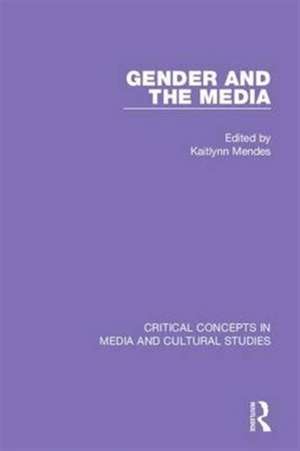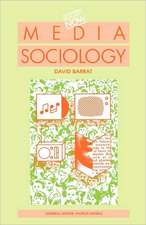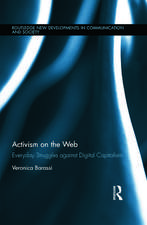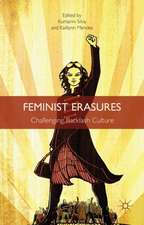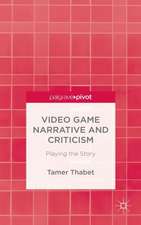Gender and the Media: Critical Concepts in Media and Cultural Studies
Editat de Kaitlynn Mendesen Limba Engleză Hardback – 24 aug 2016
Now, this new four-volume collection from Routledge’s acclaimed Critical Concepts in Media and Cultural Studies series enables users readily to access and make sense of the essential texts of gender-and-media scholarship. The collection is organized into four parts. Volume I (‘Body Counts’) assembles research on women’s absence in a range of media from around the world. Volume II (‘Representing Gender’) gathers together crucial texts on gender representations and stereotypes in the media. Volume III (‘Gender and Media Uses’), meanwhile, brings together the best research which, rather than surveying what the media does to people, explores how they use, navigate, and contest it. The final volume (‘Occupational Status, Experience, and Ownership’) presents key research which seeks to examine where men and women are placed in media organizations, how they experience these positions, and what impact they might have on media content.
Fully indexed and with an introduction newly written by the editor, Gender and the Media is an indispensable reference resource for researchers and students.
Din seria Critical Concepts in Media and Cultural Studies
- 34%
 Preț: 4807.49 lei
Preț: 4807.49 lei - 34%
 Preț: 4092.01 lei
Preț: 4092.01 lei - 34%
 Preț: 3821.08 lei
Preț: 3821.08 lei - 34%
 Preț: 3821.61 lei
Preț: 3821.61 lei - 34%
 Preț: 7023.65 lei
Preț: 7023.65 lei - 34%
 Preț: 4516.37 lei
Preț: 4516.37 lei - 34%
 Preț: 3957.02 lei
Preț: 3957.02 lei - 34%
 Preț: 2124.85 lei
Preț: 2124.85 lei - 34%
 Preț: 6456.75 lei
Preț: 6456.75 lei - 34%
 Preț: 7300.37 lei
Preț: 7300.37 lei - 34%
 Preț: 7299.56 lei
Preț: 7299.56 lei - 34%
 Preț: 4380.15 lei
Preț: 4380.15 lei - 34%
 Preț: 6740.40 lei
Preț: 6740.40 lei - 34%
 Preț: 6742.03 lei
Preț: 6742.03 lei - 14%
 Preț: 5490.66 lei
Preț: 5490.66 lei - 34%
 Preț: 6136.37 lei
Preț: 6136.37 lei - 34%
 Preț: 5628.62 lei
Preț: 5628.62 lei - 34%
 Preț: 6175.17 lei
Preț: 6175.17 lei - 34%
 Preț: 7317.18 lei
Preț: 7317.18 lei - 34%
 Preț: 3818.54 lei
Preț: 3818.54 lei - 34%
 Preț: 5486.84 lei
Preț: 5486.84 lei - 34%
 Preț: 5485.77 lei
Preț: 5485.77 lei - 34%
 Preț: 3110.43 lei
Preț: 3110.43 lei - 34%
 Preț: 6187.37 lei
Preț: 6187.37 lei - 34%
 Preț: 6195.53 lei
Preț: 6195.53 lei - 34%
 Preț: 5214.08 lei
Preț: 5214.08 lei - 34%
 Preț: 4100.55 lei
Preț: 4100.55 lei - 34%
 Preț: 7295.88 lei
Preț: 7295.88 lei - 34%
 Preț: 7296.71 lei
Preț: 7296.71 lei - 34%
 Preț: 7304.45 lei
Preț: 7304.45 lei - 34%
 Preț: 5487.88 lei
Preț: 5487.88 lei - 34%
 Preț: 7298.74 lei
Preț: 7298.74 lei - 34%
 Preț: 6747.74 lei
Preț: 6747.74 lei - 14%
 Preț: 6459.60 lei
Preț: 6459.60 lei
Preț: 6735.52 lei
Preț vechi: 10208.69 lei
-34% Nou
Puncte Express: 10103
Preț estimativ în valută:
1288.81€ • 1349.26$ • 1066.43£
1288.81€ • 1349.26$ • 1066.43£
Carte tipărită la comandă
Livrare economică 05-19 aprilie
Preluare comenzi: 021 569.72.76
Specificații
ISBN-13: 9781138827516
ISBN-10: 1138827517
Pagini: 1638
Ilustrații: 29
Dimensiuni: 156 x 234 x 107 mm
Greutate: 2.81 kg
Ediția:1
Editura: Taylor & Francis
Colecția Routledge
Seria Critical Concepts in Media and Cultural Studies
Locul publicării:Oxford, United Kingdom
ISBN-10: 1138827517
Pagini: 1638
Ilustrații: 29
Dimensiuni: 156 x 234 x 107 mm
Greutate: 2.81 kg
Ediția:1
Editura: Taylor & Francis
Colecția Routledge
Seria Critical Concepts in Media and Cultural Studies
Locul publicării:Oxford, United Kingdom
Public țintă
Postgraduate and UndergraduateCuprins
Gender and the Media
Volume I: Body Counts
Part 1: Media Monitoring, News and Gender
Volume I: Body Counts
Part 1: Media Monitoring, News and Gender
- Margaret Gallagher, ‘The Case for Monitoring and Advocacy’, in Gender Setting: News Agendas for Media Monitoring and Advocacy (London & New York: Zed Books, 2001), pp. 3-23.
- Monica Djerf-Pierre, ‘The Gender of Journalism: The Structure and Logic of the Field in the Twentieth Century’, Nordicom Review, 28, 2007, 81–104.
- Patricia Holland, ‘When a Woman Reads the News’, in H. Baehr and G. Dyer (eds), Boxed In: Women and Television (London: Routledge, 1987), pp. 133-150.
- Knut De Swert and Marc Hooghe, ‘When Do Women Get a Voice? Explaining the Presence of Female News Sources in Belgian News Broadcasts (2003—5)’, European Journal of Communication, 25, 1, 2010, 69-84.
- Louise North, ‘The Gendered World of Sports Reporting in the Australian Print Media’ JOMEC Journal, 2012.
- Stine Eckert and Linda Steiner, ‘(Re)triggering Backlash: Responses to News About Wikipedia's Gender Gap’, The Journal of Communication Inquiry, 37, 4, 2013, 284-303.Part 2: Women in Politics
- Pippa Norris, 'Running as a Woman: Gender Stereotyping in Women's Campaigns', in Shanto Iyengar, Nicholas A. Valentino, Stephen Ansolabehere and Adam F. Simon, Women, Media and Politics (Oxford: Oxford University Press, 1997), pp. 77-98.
- Elisabeth Gidengil and Joanna Everitt, ‘Conventional Coverage / Unconventional Politicians: Gender and Media Coverage of Canadian Leaders' Debates, 1993, 1997, 2000’, Canadian Journal of Political Science, 36, 3, 2003, 559-577.
- Erika Falk, ‘Baking Muffins and Bombing Countries’, in Women for President: Media Bias in Nine Campaigns (Urbana and Chicago: University of Illinois Press, 2010), pp.52-82.
- Charlotte Adcock, ‘The Politician, The Wife, The Citizen, and her Newspaper: Rethinking Women, Democracy, and Media(ted) Representation’, Feminist Media Studies, 10, 2, 2010, 135-59.
- Emily Harmer, ‘Seen and Not Heard: The Popular Appeal of Postfeminist Political Celebrity’, in H. Savigny and H. Warner (eds), The Politics of Being a Woman: Feminism, Media and 21st Century Popular Culture (New York: Palgrave Macmillan, 2015), pp. 27-48.
- Volume II: Representing Gender
Part 1: Housewives & Subordinate Women
12. Betty Friedan, ‘The Happy Housewife Heroine’, in The Feminine Mystique (New York: W.W. Norton, 2002 [1963])), pp. 33-68. - Gaye Tuchman, ‘The Symbolic Annihilation of Women by the Mass Media’, in G. Tuchman, A. Kaplan Daniels, and J. Benet (eds), Hearth and Home: Images of Women in the Mass Media (New York: Oxford University Press, 1978), pp. 3-38.
- Erving Goffman, Gender Advertisements (New York & London: Harper & Row, 1979), pp. 24-27.Part 2: Love, Romance & Female Fantasy
- Tania Modleski, ‘The Search for Tomorrow in Today’s Soap Operas’, in Loving with a Vengeance: Mass-Produced Fantasies for Women (London: Methuen, 1984), pp. 35-58.
- Angela McRobbie, ‘Jackie Magazine: Romantic Individualism and the Teenage Girl’, in Feminism and Youth Culture, 2nd, ed. (Basingstoke: Palgrave Macmillan, 2000), pp. 67-117.
- Susan H. Alexander, ‘Messages to Women on Love and Marriage From Women’s Magazines’ in M. Meyers (ed.), Mediated Women: Representations in Popular Culture (Cresskill, NJ: Hampton Press, 1999), pp. 25-37.Part 3: Sexualization, Visual Pleasure and Culture
- Laura Mulvey, ‘Visual Pleasure and Narrative Cinema’, Screen, 16, 3, 1975, 6-18.
- Rosalind Gill, ‘Empowerment/Sexism: Figuring Female Sexual Agency in Contemporary Advertising’, Feminism & Psychology, 18, 1, 2008, 35-60.
- Feona Attwood, ‘Pornography and Objectification’, Feminist Media Studies, 4, 1, 2004, 7-19.
- Annabelle Mooney, ‘Boys Will be Boys: Men’s Magazines and the Normalisation of Pornography’, Feminist Media Studies, 8, 3, 2008, 247-265.Part 4: Postfeminism and Popular Culture
- Rosalind Gill, ‘Postfeminist Media Culture: Elements of a Sensibility’, European Journal of Cultural Studies, 10, 2, 2007, 147-66.
- Kaitlynn Mendes ‘The Lady is a Closet Feminist!: Discourses of Backlash and Postfeminism in British and American Newspapers’, International Journal of Cultural Studies, 14, 6, 2011, 1-17.
- Hannah Hamad, 'Hollywood's Hot Dads': Tabloid, Reality and Scandal Discourses of Celebrity Post-Feminist Fatherhood’, Celebrity Studies, 1, 2, 2010, 151-69.
- Imelda Whelehan, ‘Ageing Appropriately: Postfeminist Discourses of Ageing in Contemporary Hollywood Cinema’, in J. Gwynne and I. Whelehan (eds), Postfeminism and Contemporary Hollywood Cinema (Basingstoke: Palgrave Macmillan, 2013), pp. 78-96Part 5: Masculinities
- Jeffery P. Dennis, ‘Men, Masculinities and the Cave Man’, in K. Ross (ed.), The Handbook of Gender, Sex and Media (Malden, MA, Oxford, & Chichester: Wiley-Blackwell, 2012), pp. 107-117.
- Tim Edwards, ‘Sex, Booze and Fags: Masculinity, Style and Men’s Magazines’, in B. Benwell (ed.), Masculinity and Men’s Lifestyle Magazines (Oxford & Malden, MA: Blackwell Publishing, 2003), pp.132-146.
- Federico Boni, ‘Framing Media Masculinities: Men's Lifestyle Magazines and the Biopolitics of the Male Body’, European Journal of Communication, 7, 4, 2002, 465-478.
- Laura Hurd Clarke, Erica V. Bennett, and Chris Liu ‘Aging and Mmasculinity: Portrayals in Men's Magazines’, Journal of Aging Studies, 31, 2014, 26-33.Part 6: Mediated Sexuality
- Audrey Yue, ‘Sexualities/Queer Identities’, in C. Carter, L. Steiner and L. McLaughlin (eds), The Routledge Companion to Media and Gender (Abingdon and New York: Routledge, 2014), pp. 81-91.
- Guillermo Avila-Saavedra, ‘Nothing Queer about Queer Television: Televised Construction of Gay Masculinities’, Media, Culture & Society, 31, 1, 2009, 5-21.
- Bernadette Barker-Plummer, ‘Fixing Gwen: News and the Mediation of (trans)Gender Challenges’, Feminist Media Studies, 13, 4, 2013, 710-724.Part 7: Representations of Violence against Women
- Cynthia Carter, ‘When the ‘Extraordinary’ Becomes ‘Ordinary’: Everyday News of Sexual Violence’ in C. Carter, G. Branston, and S. Allan (eds), News, Gender and Power (London and New York: Routledge, 1998), pp. 219-232.
- Sujata Moorti, ‘The Right of Sight is White: The Singular Focus if Network News’, in The Color of Rape (NY: State University Press of New York, 2002), pp.71-112.
- Ammu Joseph and Kelpana Sharma, Whose News? The Media and Women’s Issues (New Delhi; London: Sage Publications, 1994), pp 33-42.
- Paulina García-Del Moral, ‘Representation as a Technology of Violence: On the Representation of the Murders and Disappearances of Aboriginal Women in Canada and Women in Ciudad Juarez’, Canadian Journal of Latin American and Caribbean Studies, 36, 72, 2011, 33-62.
- Sarah Halim and Marian Meyers, ‘News Coverage of Violence Against Muslim Women: A View From the Arabian Gulf’, Communication, Culture & Critique, 3, 1, 2010, pp. 85-104.
- Meenakshi Gigi Durham, ‘Blood, Lust and Love: Interrogating Gender Violence in the Twilight Phenomenon’, Journal of Children and Media, 6, 3, 2012, pp. 281-299.
- Volume III: Gender, Audiences and Media Use
Part 1: Gender and Cultural Production - Mary Celeste Kearney, ‘Delightful Employment: Girls’ Cultural Production Prior to the Late Twentieth Century’, in Girls Make Media (Routledge: New York & London, 2006), pp. 19-48.
- Alison Piepmeier, ‘"If I Didn’t Write These Things No One Else Would Either": The Feminist Legacy of Grrrl Zines and the Origins of the Third Wave’, in Girl Zines: Making Media, Doing Feminism (New York: New York University Press, 2009), pp. 23-55.
- Alison Harvey, ‘Twine’s Revolution: Democratization, Depoliticization, and the Queering of Game Design’, GAME: The Italian Journal of Game Studies, 3, 2014, 95-107.
- Amy Adele Hasinoff, ‘Sexting as Media Production: Rethinking Social Media and Sexuality’, New Media & Society, 15, 4, 2013, 449-65.Part 2: Reading Romance, Teen Fiction and Magazines
- Rhadika Parmeswan, ‘Reading Fictions of Romance: Gender, Sexuality and Nationalism in Postcolonial India’, Journal of Communication, 52, 4, 2002, 832-852.
- Dawn H. Currie, ‘Decoding Femininity: Advertisements and their Teenage Readers’, Gender & Society, 11, 1997, 453-477.
- Elizabeth Frazer, ‘Teenage Girls Reading Jackie’, Media, Culture and Society, 9, 4, 1987, 407-425.
- Alexander Dhoest and Nele Simons, ‘Questioning Queer Audiences: Exploring Diversity and Lesbian and Gay Men’s Media Uses and Readings’, in K. Ross (ed.), The Handbook of Gender, Sex and Media (Malden, MA, Oxford, & Chichester: Wiley-Blackwell, 2012), pp. 260-276.Part 3: Gendered Responses to Media Technologies
- Lynn Spigel, ‘Installing the Television Set: Popular Discourses on Television and Domestic Space, 1948-1955’, in L. Spigel and D. Mann (eds), Private Screenings: Television and the Female Consumer (Minneapolis, MN, USA: University of Minnesota Press, 1992), pp. 3-40.
- Helen Wood, ‘Television—the Housewife's Choice? The 1949 Mass Observation Television Directive, Reluctance and Revision’, Media History, 21, 3, 2015, 1-18.
- Andrea L. Press, ‘Women’s Experiences with Television: The Evolution of the Meaning of Television Through the Generations’, in Women Watching Television: Gender, Class and Generation in the American Television Experience (Philadelphia: University of Pennsylvania Press, 1991), pp. 53-62.Part 4: Gender and Digital Feminist Activism
- Jessalynn M. Keller, ‘Virtual Feminism: Girls' Blogging Communities, Feminist Activism, and Participatory Politics’, Information, Communication & Society, 15, 3, 2011, 429-447.
- Sonia Nuñez Puente, ‘Feminist Cyberactivism: Violence against Women, Internet Politics and Spanish Feminist Praxis Online’, Continuum: Journal of Media and Cultural Studies, 25, 3, 2011, 333-346.
- Laura Rapp, Deeanna M. Button, Benjamin Fleury-Steiner, and Ruth Fleury-Steiner, ‘The Internet as a Tool for Black Feminist Activism: Lessons From an Online Antirape Protest’, Feminist Criminology, 5, 3, 2010, 244-262.
- Frances Shaw, ‘"Hottest 100 Women": Cross-Platform Discursive Activism in Feminist Blogging Networks’, Australia Feminist Studies, 27, 74, 2012, 373-87.
- Annabelle Sreberny, ‘Women's Digital Activism in a Changing Middle East’, International Journal of Middle East Studies, 47, 2, 2015, 357-361.Part 5: Gender and Games Culture
- Janine Fron, Tracy Fullerton, Jacquelyn Ford Morie, and Celia Pearce, ‘The Hegemony of Play’, Situated Play: Proceedings of the 2007 Digital Games Research Association Conference (Tokyo: Japan, 2007), pp. 308-319.
- Diane Carr, ‘Contexts, Gaming Pleasures, and Gendered Preferences’,Simulation & Gaming, 36, 4, 2005, 464-482.
- Anastasia Salter and Bridget Blodgett, ‘Hypermasculinity & Dickwolves: The Contentious Role of Women in the New Gaming Public’, Journal of Broadcasting & Electronic Media, 56, 3, 2012, 401-416.Part 6: Soap Operas, Telenovas and (Resisting) Audiences
- Ellen Seiter, Hans Borcher, Gabriele Kreutzner and Eva-Maria Warth, ‘Don’t Treat Us like We’re So Stupid and Naïve: Towards an Ethnography of Soap Opera Viewers’, in Ellen Seiter, Hans Borcher, Gabriele Kreutzner and Eva-Maria Warth (eds), Remote Control: Television, Audiences and Cultural Power (London: Routledge, 1991), pp. 223-47.
- Myria Georgiou, ‘Watching Soap Opera in the Diaspora: Cultural Proximity or Critical Proximity?’ Ethnic and Racial Studies, 35, 5, 2012, 868-87.
- Frederik Dhaenens, ‘Queer Cuttings on YouTube: Re-editing Soap Operas as a Form of Fan-Produced Queer Resistance’, European Journal of Cultural Studies, 15, 4, 2012, 442-56.
- Volume IV: Occupational Status, Practices, Experience and Ownership
Part 1: Gender, Media Ownership, Status & Decision Making
61. Carolyn M. Byerly. ‘Factors Affecting the Status of Women Journalists: A Structural Analysis’, in Carolyn M. Byerly (ed.), The Palgrave International Handbook of Women and Journalism (Basingstoke: Palgrave Macmillan, 2013), pp. 11-23. - Carolyn M. Byerly, ‘Media Conglomeration and Women’s Interests: A Global Concern’, Feminist Media Studies, 14, 2, 2014, 322-6.
- Aimée Vega Montiel, ‘Intersections between Feminism and the Political Economy of Communication: Women's Access to and Participation in Mexico's Media Industries’, Feminist Media Studies, 12, 2, 2012, 310-316.
- Ammu Joseph, ‘Working, Watching, and Waiting: Women and Issues of Access, Employment, and Decision-making in the Media in India’, in K. Ross and C.M. Byerly (eds), Women and Media: International Perspectives (Malden, MA: Blackwell Publishing, 2004), pp. 132-156.Part 2: Gendered Experiences and in Media Industries
- Cho Sooyoung and Lucinda D. Davenport, ‘Gender Discrimination in Korean Newsrooms’, Asian Journal of Communication, 17, 3, 2007, 286-300.
- Louise North, ‘"Just a little Bit of Cheeky Ribaldry"?: Newsroom Discourses of Sexually Harassing Behaviour’, Feminist Media Studies, 7, 1, 2007, 81-96.
- Aida Opoku-Menash, ‘Hanging in There: Women, Gender, and Newsroom Cultures in Africa’, in Marjan de Bruin & Karen Ross (eds), Gender and Newsroom Cultures: Identities at Work (Cresskill: NJ, Hampton Press, 2004), pp. 107–120.
- A. Willard, ‘Why Do Women Leave Newspaper Jobs?’, Quill, May 2007, p. 23.Part 3: Gendered Cultures, Practices, and Identities in Media
- Randal A. Beam and Damon T. DiCicco, ‘When Women Run the Newsroom: Management Change, Gender and the News’, Journalism & Mass Communication Quarterly, 87, 2, 2010, 393-411.
- Tracy Everbach, ‘The Culture of a Women-Led Newspaper: An Ethnographic Study of the Sarasota Herald-Tribune’, Journalism & Mass Communication Quarterly, 83, 2006, 477-493.
- Aliza Lavie & Sam Lehman-Wilzig, ‘Whose News?: Does Gender Determine the Editorial Product?’, European Journal of Communication, 18, 1, 2003, 5-29.
- Monica Löfgren Nilsson, ‘"Thinkings" and "Doings" of Gender: Gendering Processes in Swedish News Production’, Journalism Practice, 4, 1, 2010, 1-16.
- Thomas Hanitzsch and Folker Hanusch, ‘Does Gender Determine Journalists’ Professional Views? A Reassessment Based on Cross-National Evidence’, European Journal of Communication, 27, 3, 2012, 257-77.
- Lucie Schoch, ‘Feminine’ Writing: the Effect of Gender on the Work of Women Sports Journalists in the Swiss Daily Press’, Media, Culture & Society, 35, 6, 2013, 708-723.
- Marian Meyers and Lynne Gayle, ‘African American Women in the Newsroom: Encoding Resistance’, Howard Journal of Communications, 26, 3, 2015, 292-312.Part 4: Feminist Political Economy of Communication
- Lisa McLaughlin, ‘Looking for Labor in Feminist Media Studies’, Television & New Media, 10, 1, 2008, 110-113.
- Micky Lee, ‘A Feminist Political Economic Critique of the Human Development Approach to New Information and Communication Technologies’, International Communication Gazette, 73, 6, 2011, 524-538.
- Deborah Tudor and Eileen R. Meehan, ‘Demoting Women on the Screen and in the Board Room’, Cinema Journal, 53, 1, 2013, 130-136.
- Eileen R. Meehan, ‘Heads of Household and Ladies of the House: Gender, Genre, and Broadcast Ratings, 1929–1990’, in W.S. Solomon and R.W. McChesney (eds), Ruthless Criticism: New Perspectives in US Communication History, (Minneapolis: University of Minnesota Press, 1993), pp. 204–221.Part 5: Feminist Assessments and Interventions in Media Policy
- Leslie Regan Shade, ‘Gender and Digital Policy: From Global Infrastructure to Internet Governance’, in C. Carter, L. Steiner and L. McLaughlin (eds), The Routledge Companion to Media and Gender (Abingdon and New York: Routledge, 2013), pp. 222-232.
- Margaret Gallagher, ‘Gender and Communication Policy: Struggling for Space’, in R. Mansell and M. Raboy (eds), The Handbook of Global Media and Communication Policy (Malden, MA, Oxford, and Chichester: Willey-Blackwell, 2011), pp. 451-467.
- Katharein Sarikakis and Elaine Thao Nguyen, ‘The Trouble with Gender: Media Policy and Gender Mainstreaming in the European Union’, Journal of European Integration, 31, 2, 2009, 201-216.
Descriere
Scholars have long recognized the media’s role in shaping and reflecting the way we see the world, ourselves, and others. In particular, they have understood that ‘the media’ plays a vital part in the policing and construction of gender. Moreover, as new types of media proliferate, and become increasingly important in our daily lives, addressing the sometimes difficult questions surrounding the relationship between gender and the media is more important than ever.
This new four-volume collection from Routledge’s acclaimed Critical Concepts in Media and Cultural Studies series enables users readily to access and make sense of the essential texts of gender-and-media scholarship. Fully indexed and with an introduction newly written by the editor, Gender and the Media is an indispensable reference resource for researchers and students.
This new four-volume collection from Routledge’s acclaimed Critical Concepts in Media and Cultural Studies series enables users readily to access and make sense of the essential texts of gender-and-media scholarship. Fully indexed and with an introduction newly written by the editor, Gender and the Media is an indispensable reference resource for researchers and students.
